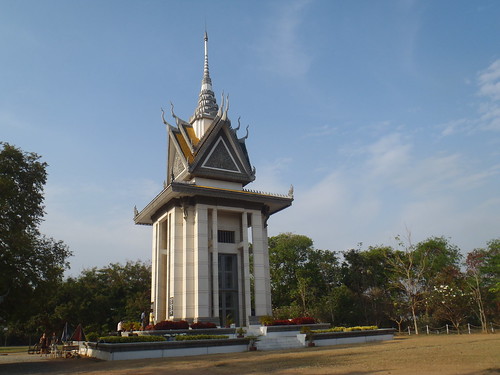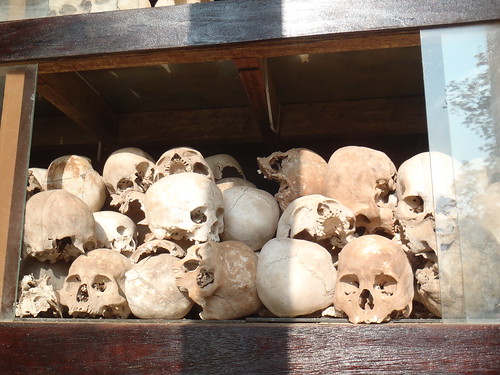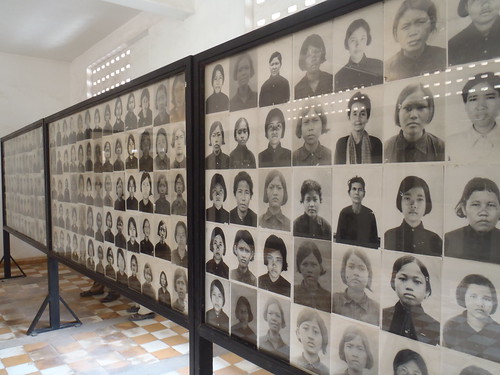Traveling in South East Asia can be a lot of things: fun, beautiful, delicious. But sometimes, it can also be a very dark place. The latter half of the twentieth century was not so kind to mainland South East Asia, and it’s impossible to ignore the repercussions of this.
Over the past few months I’ve learned a lot about the American War in Vietnam, and the Secret War in Laos but nothing was able to prepare me for the carnage associated with Cambodia. In just a 4 year span between 1975 and 1979 over 1.5 million Cambodians (a quarter of the countries population) were killed by their own tyrannical government. The ultra-communist Khmer Rouge, sought to destroy everything modern and turn Cambodia into a giant agrarian collective. They killed every intellectual, person of wealth or political official, evacuated all cities and basically propelled the country back to the Stone Age until they were overthrown by the Vietnamese.
Aside from watching the movie The Killing Fields, in high school, I knew very little about this dark chapter of history. I think it’s impossible to visit Cambodia and not be informed about this, so my first few days in Phnom Penh were dedicated to learning about this time period.
The Killing Fields

There are a number of sites in Cambodia known as the Killing Fields. They are all mass graveyards where thousands of people were executed- usually beaten to death to save valuable bullets. The most famous of these fields is Choeung Elk, about 17km outside of Phnom Penh, which is now a memorial site.
The first thing you see upon arriving is the Buddhist stupa which towers over the field. As you get closer you realize that this monument is filled to the top with human skulls. I studied evolutionary biology in college, and I’ve handled human skulls before, but nothing could have prepared me for this mountain of bones. Many of the skulls have been damaged or smashed in. They stare out, eyelessly bearing witness.

What is left now in the killing fields are a series of mass graves, some have been excavated, others are merely labeled pits. After heavy rains bone fragments and teeth are known to rise up out of the dead land. It hadn’t rained in months, but even so I could see dozens of scraps of clothing, reaching out of the earth like disembodied hands.
The oddest thing about Choeung Elk the eery peacefulness of the place. There are beautiful trees and a pleasant algae covered lake. It was a beautiful day and the entire area seemed calm. Nearby their was a school where we could hear children singing. The juxtaposition was epically creepy.

S-21
The next day I visited the Tuol Sleng Genocide Museum, in downtown Phnom Penh. It may not have been the best idea to cram both of these sites into a 24 hour period, but I didn’t have much time in the city and very much wanted to see both.
Tuol Sleng, or S-21, was once a high school, haphazardly converted into a Khmer Rouge prison. It’s new role was primarily the gruesome torture and execution of political prisoners. The government’s idea of what constituted a political prisoner was pretty liberal- men, women, children and even babies were imprisoned here, over 20,000 people total. Of all of the people who entered the prison only seven walked out alive. Yes, that is correct, seven. Most others met their ends in the killing fields.
If the Killing Fields were heartbreaking, S-21 was absolutely horrifying. It’s a horror movie, a place of nightmares. The buildings have been preserved basically as they were in 1979. Large classrooms with metal beds and torture instruments made up one building. Another has been subdivided into prison cells the size of coat closets, dark and claustrophobic. Barbed wire lined the outside, a sign told me it was to prevent prisoners from committing suicide.

It’s hard to even conceive of the amount of misery that occurred inside these walls, but there are pictures to help. The Khmer Rouge took mug shots of every person who was incarcerated here, these blown up shots are now posted on chalkboards all through the museum. Walls and walls of faces, young and old, thin and beautiful, scared and tough. It adds a heartbreaking touch of humanity to his harsh place.

One thing that made my experience almost unbearably human: a tour group of elderly Cambodians touring the museum at the same pace as myself. By my math, anyone over the age of 35 must have some memories of that time period, these men and women, in their 60’s or 70’s, must have a lot of burden to carry. I watched them explore the museum. One woman grimly pointed to a chalkboard photo of a man on a bed, being tortured, then at the floor. The tile pattern is the same.
In the corner of the room were some old stone busts, which must have decorated the prison in earlier times. As I examined them a man walked over, pointed at one and said “Pol Pot.” He then very swiftly and very passionately kicked the bust in the head, before walking away.

This got me, more than anything else in this museum of suffering. I started to feel intensely claustrophobic as the feelings closed in on me. I had to leave, to go sit in the open air of the courtyard, feel sunshine and watch the birds. Watch some life happening.
Later
It can be exhausting you know, the memorials of such suffering. I’ve been to more then my share of them these past six months: the Hiroshima Peace Park, the American War Museum, the Hanoi Hilton, Phonsavan. Every one of these places brings up deep and troubling emotions, particularly as an American. After a day of bearing witness, I find myself physically exhausted. I can’t even write about it; all I want to do is watch How I Met Your Mother reruns and forget that the world exists.
Nonetheless, I think that these, less pleasant days of travel, are so important. It’s essentially to be aware of the world around you, the context of every country you visit- and you can’t just get it from Wikipedia entries. Staring at those forgotten scraps of cloth, tearing their way out of the ground, I think I better understand the Cambodia of today- a place that is troubled but very optimistic. I’ve never seen more smiling people than I have in this country. And, in the same way that knowing someones secrets makes you feel closer to them, I think I now love Cambodia a little more.
